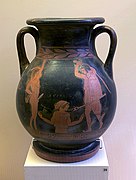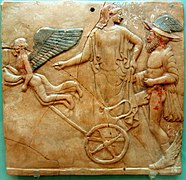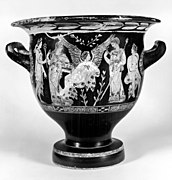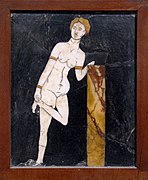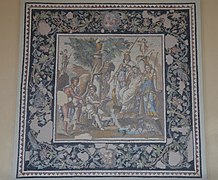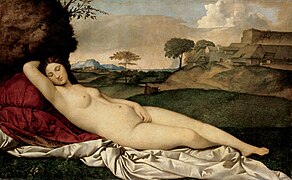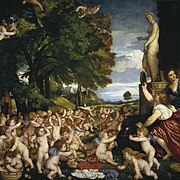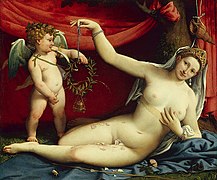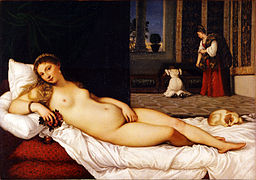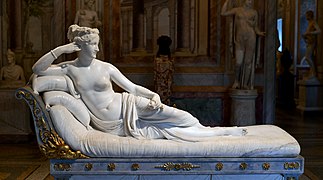Aphrodite
Aphrodite (in ancient Greek, Ἀφροδίτη) is, in Greek mythology, the goddess of beauty, sensuality and love. The Roman equivalent of her is Venus. Although she is often referred to in modern culture as "the goddess of love," it is important to note that in ancient times love was not referred to in the romantic but erotic sense.
Although in mythology she was married to Hephaestus, she had other lovers, Ares being her favourite, and she also had relationships with Hermes to mention. Along with her siblings, she held a place in the pantheon among the twelve Olympian gods. Meanings come from its name, such as the words aphrodisiac or hermaphrodite, and from its ancient Roman name (Venere) come to venerate and venereal (referring to the sexual).
Origins
Aphrodite has numerous equivalents: Inanna in Sumerian mythology, Astarte in Phoenician mythology, Turan in Etruscan mythology, and Venus in Roman mythology. She has parallels with Indo-European goddesses of the dawn, such as Ushas or Aurora. According to Pausanias, the first to establish her cult were the Assyrians and after them Pafosianos from Cyprus and the Phoenicians who lived in Ascalon (Palestine), who taught her cult to the inhabitants of Cithera.
The name Ἀφροδίτη was related by popular etymology to ἀφρός aphrós, 'foam', being interpreted as 'rising from the foam' and personifying it in an etiological myth that was already known to Hesiod. It has reflections in Messapian and Etruscan (hence "April"), which were probably borrowed from Greek. Although Herodotus was aware of Aphrodite's Phoenician origins, linguistic attempts to derive the name "Aphrodite" from Semitic Aštoret, via undocumented Hittite transmission, remain inconclusive. A suggestion by Hammarström, rejected by Hjalmar Frisk, relates the name to "πρύτανις", a Greek loanword from a cognate of Etruscan (e)pruni, 'lord' or similar. Mallory and Adams offer an etymology of Indo-European abhor, 'very' + dhei, 'to shine'. If derived from Semitic, a plausible etymon would be barīrĩtu Assyrian, a female demon found in middle and late Babylonian texts. The name may mean "she who [comes] at dusk", a manifestation of the planet Venus as the evening star, a well-known attribute of the Mesopotamian goddess Inanna /Ishtar.
Worship
The epithet Aphrodite Acidalia was occasionally added to her name, after the source she used to bathe in, located in Boeotia. She was also called Cipris or Cipria (Kypris) and Citerea (Cytherea) by their presumed birthplaces in Cyprus and Kythera, respectively. The island of Cythera was an important center of her cult. She was associated with Hesperia and was frequently accompanied by the Carites, the goddesses of festivities.
Aphrodite had her own festivals, the Aphrodisias, which were celebrated throughout Greece, but particularly in Athens and Corinth. In the temple of Aphrodite located on top of the Acrocorinth (before the Roman destruction of the city in 146 BC) sexual relations with her priestesses were considered a method of worshiping the goddess. This temple was not rebuilt when the city was refounded under Roman rule in 44 BC. C., but it is likely that fertility rituals persisted in the city, near the agora.
Aphrodite was associated with the sea, and was often depicted with it and with dolphins, doves, swans, clams, scallops, pearls, and trees such as the pomegranate, apple, myrtle, and roses.
Worship today
Aphrodite is one of the deities worshiped in the current dodecate cult. Common offerings offered to the goddess are pomegranates, apples, and limes. One of the simplest modern rituals and part of a popular tradition, consists of swimming around the rock Petra Toy Romiou in Cyprus between Limasol and Paphos, where Aphrodite was born. This ritual would assure the person who performs it of eternal beauty or at least being lucky in love.
Ritual prostitution
A universal aspect of the cult of Aphrodite and her predecessors that many 19th and 20th century mythographers have omitted is the practice of religious prostitution at her shrines and temples. The Greek euphemism for these prostitutes is hierodula, 'sacred servant'. This custom was an inherent practice in rituals dedicated to the Middle Eastern ancestors of Aphrodite, the Sumerian Inanna and the Akkadian Ishtar, whose temple harlots were 'Ishtar's women', ishtarium. The practice has been documented in Babylonia, Syria, and Palestine, in Phoenician cities, and in the Tyrian colony of Carthage, and for the Hellenic Aphrodite in Cyprus, the center of her cult, Cythera, Corinth, and Sicily. Aphrodite is everywhere the patroness. of the heteras and courtesans. In Ionia, on the coast of Asia Minor, the hierodules served in the temple of Artemis.
Late Roman Period
During the Roman period (from the II century AD), the cult of Aphrodite spread over everything in the East (Syria and Egypt), appearing there as a Hellenized form of Isis, Hathor or Astarte. In the lists that appear in marriage contracts, from the I century, sometimes bronze statuettes or, more rarely silver, which were not included in the dowry and remained the property of the woman after marriage. In the lararium of the houses there are sometimes images of the goddess following Greek models, but produced by local workshops and to which other attributes can be added, as is typical of Hellenistic syncretism.
Aphrodite Urania and Aphrodite Pandemos
At the end of the century V a. C., the philosophers would have separated Aphrodite into two different goddesses, but indistinct in worship: Aphrodite Urania, born from the foam after Cronus castrated Urano, and Aphrodite Pandemos, the common Aphrodite 'of all the people', born of Zeus and Dione. Among Neoplatonists and eventually their Christian interpreters, Aphrodite Urania figures as the heavenly Aphrodite, representing love of body and soul, while Aphrodite Pandemos was associated with mere physical love.
The depiction of Aphrodite Urania, with one foot resting on a tortoise, was later interpreted as emblematic of the discretion of conjugal love; the image is attributed to Phidias, in a chryselephantine sculpture made for Elis, of which we have only a passing comment from Pausanias.
For this reason, according to Plato Aphrodite is two goddesses: one old and the other young. The eldest, Urania, is the daughter of Urano; the youngest is called Pandemos, and she is the daughter of Zeus and Dione. Pandemos is the common Aphrodite. Pausanias' speech distinguishes two manifestations of Aphrodite, represented by two stories: Aphrodite Urania ('heavenly') and Aphrodite Pandemos ('common').
Birth
In the case of the first story, the birth occurs at the moment Cronos cuts off the genitals of his father Uranus and throws them into the sea, from where Aphrodite emerges.. Hence she is known as & # 34; the goddess born of the waves & # 34; or "born of the semen of god".
The 'risen from the foam' Aphrodite was born from the sea, near Paphos (Cyprus) after Cronus cut off Uranus's genitals with a sickle and threw them into the sea after him. In his Theogony, Hesiod recounts that the genitals “were then carried away by the sea for a long time. Around her a white foam arose from the immortal member and in the midst of it was born an adult maiden. This myth of Venus (the Roman name for Aphrodite) born into adulthood, Venus Anadyomena ('Venus rising from the sea'), was one of the iconic depictions of Aphrodite, famous for the much-admired painting by Apelles, today lost, but described by Pliny the Elder in his Naturalis Historia. Because of this, Aphrodite is from a generation before Zeus. Homer, however, tells in book V of the Iliad another version of her origin, according to which she would be the daughter of Zeus and Dione, who was the original oracular goddess ("Dione" simply means 'goddess ', feminine form of Δíος, 'goddess', the genitive of «Zeus») in Dodona. According to Homer, Aphrodite, venturing into battle to protect her son Aeneas from her, is wounded by Diomedes and returns to her mother, falling to her knees to be comforted. «Dione» seems to be equivalent to Gaea, Mother Earth, whom Homer transferred to Olympus and alludes to a hypothetical original Proto-Indo-European pantheon, with the chief god (Di-) represented by the sky and lightning and the chief goddess (feminine form of Di-) represented as earth or fertile soil. Aphrodite herself was sometimes called "Dione". Once the cult of Zeus had usurped the oak-oracle of Dodona, some poets considered him the father of Aphrodite.
The main center of Aphrodite worship remained at Paphos, on the southwest coast of Cyprus, where the goddess of desire had long been worshiped as Ishtar and Astarte. She is said to have tentatively landed first at Kythera, a stopping place for trade and culture between Crete and the Peloponnese. Thus perhaps we have clues to the path of the original cult of Aphrodite from the Levant to the Greek mainland.
Some authors consider that Aphrodite was the daughter of Thalassa, the female personification of the sea, and Zeus.
Adult Life
Aphrodite had no childhood: in all images and references she was born an adult, nubile, and infinitely desirable. In many of the late minor myths in which she participates she is portrayed as vain, capricious, moody, and touchy. Although she married into the Greek pantheon, she is unfaithful to her husband, something common on Olympus. Hephaestus is one of the most even-tempered Hellenic deities; in the story collected in the Odyssey Aphrodite seems to prefer Ares, the fickle god of war. He is one of the few characters who played a major role in the original cause of the Trojan War itself: not only did he offer Helen of Sparta to Paris, but the kidnapping took place when he saw Helen for the first time., he was overwhelmed by the desire to possess her, which corresponds to the sphere of Aphrodite.
Marriage to Hephaestus
Because of her immense beauty, Zeus feared that Aphrodite would be the cause of violence among the other gods. He therefore married her to Hephaestus, the stern, lame ("lame") and ill-tempered god of fire and the forge. Another version of this story tells that Hera, the mother of Hephaestus, threw him from Olympus, considering him ugly and deformed. He obtained his revenge on her by trapping her in a magical throne and demanding the hand of Aphrodite in exchange for her release. Hephaestus was overjoyed to have married the goddess of beauty and forged beautiful jewelry for her, including the basket, a belt that made her even more irresistible to men.
Romance with Ares and other gods
Aphrodite's unhappiness with her marriage caused her to seek the company of others, especially Ares, the Olympian god of war. Hephaestus was informed of the adultery that his wife had with Ares by Helios. He then planned to trap them with a network of invisible chains that he had arranged on the bed, capable of immobilizing them. Ares knew that Hephaestus would return home at sunrise, so he preemptively arranged for his favorite henchman, Alectryon, to warn him. But Alectrion fell asleep. Sure enough, the sun rose, and the nets fell on Ares and Aphrodite "in full occasion," and they lay motionless. The enraged Hephaestus called out all the other Olympian gods to mock them ("the goddesses stayed at home, all out of shame"); and on the contrary, the mockery fell on Hephaestus: some gods adored the beauty of Aphrodite, others commented that they would gladly take the place of Ares. Hephaestus did not release them until Poseidon promised him that Ares would pay reparations, but they both escaped as soon as he raised the net and did not keep his promise. Ares turned Alectryon into a rooster, so that he would always warn the sunrise.
Nerites a god son of Nereus and Doris. In one of the versions. even before his ascension into the sea to Olympus, he fell in love with Nerites. When it was time to join the Olympian gods, he wanted Nerites to go with her, but he refused, preferring to stay with her family at sea. even the fact that Aphrodite promised him a pair of wings didn't change his mind. The goddess, feeling despised, transformed him into a shellfish and gave the wings to her son Eros.
Hermaphroditus was the son of Aphrodite and Hermes, after whom he was named, a mixture of his parents. But feeling guilty of adultery, he separated from his son and left him on Mount Ida (Phrygia) in the care of the nymphs of the mountain, by whom he was raised.
With Dionysus she had Priapus. It is said that she had given into the arms of Dionysus, but during his expedition in India she was unfaithful to him and she lived with Adonis. On Dionysus's return, Aphrodite returned to her side, but she soon abandoned him again and went to Lampsacus to bear the god's son. Hera, disappointed by Aphrodite's lust, touched her and her magical power caused her to give birth to an extremely ugly son with unusually large genitalia.
Aphrodite and Psyche
Aphrodite appears as a minor character in the story of Eros and Psyche, which originally appeared as a digression narrated in Apuleius's novel The Golden Ass, written in the 17th century II a. C. In her Aphrodite was jealous of the beauty of a mortal woman named Psyche: her temples began to empty, the entire population began to worship this new and beautiful woman. She asked her son Eros (Cupid, in Roman mythology), to use her golden arrows to make Psyche fall in love with the ugliest man in the world. Eros agreed but ended up falling in love with Psyche himself, accidentally pricking himself with a golden arrow.
Meanwhile, Psyche's parents were concerned that their daughter was still single. They consulted an oracle who told them that she was not destined for any mortal lover, but for a creature that lived on the top of a certain mountain, whom even the gods feared. Eros had prepared the oracle to say this. Psyche resigned herself to her fate and climbed to the top of the mountain, asking the citizens who followed her to leave her and allow her to face her fate alone. There Zephyr, the west wind, floated her down gently into a cave. Psyche entered and was surprised to find it full of jewels and ornaments. Eros visited her every night in the cave and they made passionate love. He only asked her to never light any lamps because he didn't want Psyche to know who she was (her wings made him unmistakable). Her two sisters, jealous of her, convinced her that her husband was a monster and that she should stab him with a dagger. So she one night she lit a lamp, but she recognized Eros instantly and dropped her dagger. A drop of hot oil fell on Eros's shoulder, she woke him up and fled, saying: "Love cannot live where there is no trust!"
When Psyche told her jealous older sisters, they secretly rejoiced and each of them went separately to the top of the mountain and did as Psyche had told them to enter the cave, hoping that Eros would prefer them to them.. Eros was still heartbroken and did not accept them, so they died when they fell to the base of the mountain.
Psyche searched for her lover across much of Greece, eventually stumbling across a temple to Demeter, where the floor was covered with piles of mixed grain. She began to sort the grain into neat piles, and when she was done, Demeter spoke to her, telling her that the best way to find Eros was to find her mother, Aphrodite, and earn her blessing. Psyche found a temple to Aphrodite and entered it. Aphrodite assigned him a task similar to Demeter's temple, but she gave him an impossible deadline. Eros intervened, since he still loved her, and made some ants sort her grain for her. Aphrodite was enraged by this success of Psyche and told her to go to a field where some golden sheep grazed and get golden wool. Psyche went to the field and saw the sheep, but she was stopped by the god of the river that she had to cross to get to the field. He told her that the sheep were mean and cruel and could kill her, but if she waited until noon the sheep would go to the other side of the field to seek shade and go to sleep, and that then she could gather up the wool that was caught in the wool. branches and bark of trees. Psyche did so and Aphrodite was even more enraged when she saw that she had survived and passed her test.
Lastly, Aphrodite claimed that the stress of caring for her son, depressed and sick as a result of Psyche's infidelity, had caused her to lose part of her beauty. Psyche had to go to Hades and ask Persephone, the queen of the underworld, for a bit of her beauty that Psyche would keep in a black box that Aphrodite gave her. Psyche went to a tower, deciding that the shortest path to the underworld would be death. A voice stopped her at the last moment and indicated a route that would allow her to enter and return still alive, in addition to telling her how to overcome the dog Cerberus, Charon, and the other dangers on the route. Psyche appeased Cerberus with a barley cake and paid Charon a mite to take her to Hades. On the way he saw hands coming out of the water. A voice told her to throw them a barley cake, but she refused. Once there, Persephone said that she would be happy to do Aphrodite a favor. She then paid Charon and gave the other cake to Cerberus to return.
Psyche left the underworld and decided to open the box and take some of the beauty for herself, thinking that if she did this Eros would love her for sure. Inside it was a "stygian dream" that surprised her. Eros, who had forgiven her, flew into her body and wiped the sleep from her eyes, then begged Zeus and Aphrodite for her permission to marry Psyche. They agreed and Zeus made Psyche immortal. Aphrodite danced at the wedding of Eros and Psyche, and the daughter they had was called Hedoné (pleasure) or Voluptas (voluptuousness) in Roman mythology.
Adonis and other mortal lovers
Aphrodite was Adonis's lover and took part in his birth. Cinyras, the king of Cyprus, had a beautiful daughter named Myrrha. When her mother committed hubris against Aphrodite by claiming that her daughter was more beautiful than the famed goddess, Myrrha was punished with incessant lust for her own father. Cinyras refused this, but Myrrha disguised herself as a prostitute and secretly slept with her father. Eventually, Myrrha became pregnant and was discovered by Cinyras. Enraged, he chased after his daughter with a knife. Myrrha fled from him, asking the gods for mercy. They heard her prayer and turned her into a myrrh tree so that her father could not kill her. Ultimately, Cinyras committed suicide in an attempt to restore family honor.
Myrrha gave birth to a baby boy named Adonis. Aphrodite was passing by the Myrrha tree when she saw the baby and took pity on him. She put Adonis in a box and took him to Hades for Persephone to take care of him. Adonis grew up to be a stunningly beautiful young man, and Aphrodite eventually came back for him. However, Persephone hated to give him up and wanted Adonis to remain with her in the underworld. The two goddesses got into such a dispute that it forced Zeus to intercede. He decreed that Adonis spend a third of the year with Aphrodite, another third with Persephone, and another third with whomever he desired. Adonis, of course, chooses Aphrodite.
Adonis begins his year on earth with Aphrodite. One of his greatest passions is hunting, and although Aphrodite is not naturally a hunter, she participates in order to be with Adonis. They spend every waking hour together, and Aphrodite is ecstatic with him. However, her anxiety begins to grow over her neglected duties, and she is forced to leave him for a short time. Before leaving, she gives Adonis some advice: don't attack an animal that doesn't show fear. Adonis accepts the advice, but secretly doubts Aphrodite's abilities as a huntress, promptly forgetting the advice.
Not long after Aphrodite leaves, Adonis comes across a huge boar, far bigger than any he's ever seen. The boar is suggested to be the god Ares, one of Aphrodite's lovers jealous of her continued worship of Adonis. Although the boars are dangerous and charge the hunter when provoked, Adonis ignores Aphrodite's warning and pursues the giant creature. However, soon it is Adonis who is being hunted, being no match for the boar. In the attack, Adonis is castrated by the boar and bleeds to death. Aphrodite rushes back to his side, but is too late to save him and can only weep over his body. Where the blood of Adonis falls, Aphrodite makes anemones grow in his memory. She swears that on the anniversary of his death, a party will be held in her honor every year.
When Adonis dies, he returns to the underworld and Persephone is pleased to see him again. Finally, Aphrodite notices that he is there, and runs to retrieve him. Again, she and Persephone squabble over who gets to keep Adonis until Zeus intervenes. This time he says that Adonis must stay six months with Aphrodite and six with Persephone, as he should have been the first time.
Anchises was a son of Capis with Themiste. Depending on the versions he was a poor shepherd or a prince. He was loved by Aphrodite, who, in human form, joined him on Mount Ida while she was herding herds, a union from which the Trojan hero Aeneas was born.
Phaethon son of Hemera and kidnapped by Aphrodite as a child to turn him into a demon, night guardian of her sacred sanctuaries. He fathered Aphrodite of Antinous.
Butes was an Attic son of Teleonte and Zeuxipe, daughter of the river-god Eridanus, Butes joined the Argonauts. It was said that, as the Argonauts passed by the sirens, Orpheus began to play a song to counteract the influence of his singing, but only Butes jumped into the sea. However, Aphrodite saved him and took him to Lilibea (Sicily), where he was the father of Erix and Pocalion for her.
The Judgment of Paris
Both the gods and goddesses as well as various mortals were invited to the wedding of Peleus and Thetis (later to be the parents of Achilles). Only the goddess Eris (Discord) was not invited, but she appeared with a golden apple inscribed with the word kallistēi ('for the most beautiful'), which she tossed among the goddesses. Aphrodite, Hera and Athena claimed to be the most beautiful and therefore the just owner of the apple. They agreed to take the matter before Zeus, who, not wanting the favor of any goddess, left the choice in the hands of Paris of Troy. Hera tried to bribe him with a kingdom (Asia Minor), while Athena offered him wisdom, fame, and glory in battle, but Aphrodite whispered to him that if he declared her the most beautiful, she would give him the most beautiful mortal woman in the world as his wife, so that Paris chose Aphrodite. This woman was Helena. The other goddesses were enraged and through the kidnapping of Helen by Paris they provoked the Trojan War.
Pygmalion and Galatea
Pygmalion was a sculptor who had not found a woman worthy of his love. Aphrodite took pity on him and decided to teach him the wonders of love. One day, Pygmalion was inspired by a dream of Aphrodite to make an ivory woman similar to her, which he named Galatea. Pygmalion fell in love with the statue and decided that he could not live without it. He prayed to Aphrodite, who carried out the last part of her plan by breathing life into the exquisite sculpture. Pygmalion loved Galatea and they were soon married.
Another version of this myth tells that the women of the city in which Pygmalion lived were angry that he had not married, and they asked Aphrodite to force him. Aphrodite accepted and went that same night to see Pygmalion, asking him to choose a woman to marry and warning him that if not, she would do it instead of her. Not wanting to marry, Pygmalion pleaded with him for more time, asking him to allow him to make a sculpture of Aphrodite before he had to choose a bride. Flattered, he accepted it.
Pygmalion spent a lot of time making small clay sculptures of the goddess, claiming it was necessary to be able to strike the right pose. When he started making the actual sculpture, he was surprised to find that he wanted to finish it, even knowing that he would have to marry someone to do it. The reason for this was that he had fallen in love with sculpture. The more he worked on her, the more he changed her, until he was nothing like Aphrodite at all.
At the very moment Pygmalion parted ways with the finished sculpture, Aphrodite appeared and told him to choose his bride. Pygmalion chose the statue, to which Aphrodite replied that she couldn't be, asking him to choose another. Pygmalion hugged the statue, and asked Aphrodite to transform him into a statue so that he could be with her. Aphrodite took pity on him and instead breathed life into the statue.
Other stories
*In one version of Hippolytus' story, Aphrodite was the catalyst for his death. Hippolytus disdained his worship for Artemis's, and in revenge, Aphrodite caused her stepmother, Phaedra, to fall in love with him, knowing that Hippolytus would reject her. In the most popular version of the story, Euripides' Hippolytus, Phaedra sought revenge against Hippolytus by committing suicide and leaving a note telling Theseus, her husband and Hippolytus's father, that he had raped her.. Hippolytus had sworn not to mention Phaedra's love for him and nobly refused to defend himself against her despite her consequences. Theseus then cursed his son, a curse that Poseidon was obliged to fulfill and thus Hippolytus was surprised by a bull that emerged from the sea and scared his horses, causing his chariot to overturn. Curiously, this is not the death that Aphrodite plots in the play, since in the prologue she states that she expects Hippolytus to succumb to lust with Fedra and Theseus surprises them together. Hippolytus forgives his father before dying and Artemis reveals the truth to Theseus before making him swear that he will kill one of Aphrodite's loves (Adonis) in revenge.
- Some versions of Persephone's rapture by Hades put Afrodita and his son Eros as the instigators of the event. Aphrodite was upset with Demeter's decision to remove his daughter from the Olympus to avoid the harassment suffered by the gods who claimed her as a wife, and remained a virgin like Athena and Artemisa. At the same time, Afrodita also wanted to extend his influence to the Underworld, so he sent his son Eros to shoot Hades when he inspected the Nisa fields on the surface, after which he was lostly in love with Persephone when he saw it.
- Glauco de Corinto, son of Sisyphus, angered Aphrodite, who made his horses enraged during funeral games in honor of King Pelias, and fired him. His ghost was supposedly scaring the horses during the Isthmic Games.
- Aphrodite was often accompanied by the Carites, which are the Three Thanks; Aglaya (‘Belleza’), Eufrósine (‘Júbilo’) and Talia (‘Florecent’).
- Aphrodite was one of the goddess Momo moved from, which led to his expulsion from the Olympics.
- Aphrodite figure as the great-grandmother of the god Dioniso, although in other versions he appeared as his lover.
- In Book III of the Iliad of Homer, Afrodita saves Paris when he is about to be killed by Menelao.
- Aphrodite was very protective of his son, Eneas, who fought in the war of Troy. Diomedes was about to kill Eneas in battle but Aphrodite saved him. Diomedes wounded Aphrodite and dropped his son, flying to Mount Olympus. Then Eneas was enveloped by a cloud created by Apollo, who led him to Pergam, a sacred place of Troy. Artemis cured Eneas there.
- He turned Anaxáreta into a stone for reacting so despondently to Ifis' supplications to love her, even after her suicide.
- Afrodita helped Hipomenes in a race against Atalanta to win his hand, giving him three blocks with which he distracted her. However, since the couple did not thank Aphrodite, it turned them into lions.
Consorts and descendants
| Deities | Mortals | ||
|---|---|---|---|
|
|
| |
Epithets and titles
See also "Aphrodite's epithets in the Iliad".
- Acidalia, ‘from the source Acidalia’;
- Aphrodite in kepois (;φροδετικν Κ εποις), ‘of the gardens’;
- Ambologera“the one who postpones old age”;
- Anadomena (;ναδυομένη), ‘who leaves the sea’, as in Apeles’ painting;
- Androfono (),δροφόνος), ‘powerful’;
- Anosia (),σια), ‘profane’;
- Areia, (by her lover Ares), warrior;
- Automataas a source of spontaneous love.
- Baiotissmall ears, particularly in Syracuse;
- Basilis (;ασιλίς), ‘reina’;
- Caliglutes (Καλεγλουτος), ‘of the beautiful glutes’;
- Calipigia (Καλίπυγος), ‘bella fogosa’;
- Cipria or Cipris' (Κ.
- Citerea (Κυθ ρεια), ‘de Citera’;
- Despoina (Δσποινα), ‘la madam’;
- Enoplios (;όπλιος), ‘armada’;
- Epitimbidia“on the graves” (similar to Melaina and Melainis);
- Epitragidia“Behind the goat”;
- Scotia (σκοτία), ‘oscura’;
- Filopannyx, ‘Friend of the Whole Night’
- Genetilis“of maternity”;
- Hetera (;ταίρα), ‘la cortesana’;
- Melaina (Miss: λαινα), ‘negra’ (similar to Epitimbidia and Melainis);
- Melainis (Mελαινς), ‘the young black’ (similar to Epitimbidia and Melaina);
- Morfo (Mορορφο), a term that can relate to the "form" ('in various forms' or 'in beautiful forms') or to the "dream", with cult in Esparta;
- Pandemos (MERPOL γμος), ‘common to all’, a worshipped form near the Agora of Athens;
- Persefesa (κερσεφάεσα), ‘reina del inframundo’; a trait of Persephone
- Porni (GENERAL), ‘the prostitute’, or ‘meretrix’ goddess of lust;
- Praxis (GENCY EROUS), ‘of the sexual act’;
- Sosandra“savory of men”
- Timborics (Τυμβωρσχος), ‘percussionist’;
- Urania (OM.ράνια), ‘celestial’.
Temples
- Paphos Temple.
- Santorini or Thera Temple.
- Temple of Cnido, for which the Aphrodite of Cnido Praxíteles.
- Temple of Aphrodite or Venus in the Adriana Villa of Tívoli, in form tholosThat was Cnido's.
- Temple of Amatunte (Cyprus).
- Rhodes Temple.
- Temple of Aphrodisiacs.
- Temples of Aphrodite in Corinth. Corinth was known as the city of Afrodita. In this city the goddess had at least three sanctuaries: The most important one, on the top of the Acrocorinto (which had allegedly been given to the goddess by Helios), of the centuryVa. C., was small (10×16 m) and its materials were finished using to raise a Christian church in the centuryV d. C. The so-called F Temple of the West Terrace, of marble, in Ionian style, rose in the middle of the centuryI. It contained a sculpture of Hermosgenes de Citera. The third, in the Kraneion, was near the cemetery and a forest of cypresses, dedicated to Aphrodite Melainis ("black", a chronic divinity linked to those environments, which continued to have the same function in Christian times, when it became a basilica). Two other temples of Aphrodite rose in the ports, Lequeo and Céncreas. With their image they coined more types of coins than with any other divinity, except Poseidon. The Christian sources gather that at the arrival of St. Paul there were in Corinth a thousand sacred prostitutes of Aphrodite.
- Temples of Aphrodite Pandemos (Athens, Megalopolis and Thebes).
- Temple of Aphrodite Urania (Athens).
- Temple of Aphrodite in Kipois ("Afrodita de los Jardines") in the Acropolis of Athens.
- Sparta Temple. Pausanías records that, in Sparta, Aphrodite was venerated as Areia, which means "beautiful." Pausanías also says that, in Esparta and Citera, there were extremely ancient statues of worship of Aphrodite carrying weapons, being the only known case of this kind of Aphrodite worship in Ancient Greece.
- Temple of Afrodita Praxis κρα φις in Megara. The image of the goddess was ivory, before the time of Praxíteles. It was accompanied by statues of Peitho and Paregoros. The set indicates that this advocation is to be interpreted as "success in love".
- Temple of Aphrodite in Afaca (Fenicia), on Mount Lebanon. He was famous in Antiquity for the sacred prostitution that was practiced there. In the centuryIVthe Christian emperor Constantine I ordered that “all of him, with his objects of worship, should be rooted from the foundations”.
Altars and temples of Aphrodite were erected in different cities in honor of widows and concubines of the Epigones.
The Comediographer of the Century IV a. C. Filetero ironically: "everywhere there are temples of Aphrodite the lover, and in none are altars of Aphrodite, the married goddess." Although the first is an exaggeration and the second somewhat uncertain, it does reflect the state of the cult of Aphrodite in her time.
Iconography
Among the oldest images of Aphrodite are those of Mycenaean tradition, in which she appears with a dove (also an attribute of the Phoenician goddess Astarte) or mounted on a bull (VIII B.C.) In any case, the representations of female divinities in Greek sculpture (korai) always appear dressed in the sculpture archaic, a convention that remains, even for Aphrodite, at the beginning of classical sculpture in the V century B.C. C., as demonstrated by the Aphrodite Sosandra of Calamis (ca. 460 BC) and the so-called "group of Aphrodite" on the eastern pediment of the Parthenon, the work of Phidias (or perhaps by Alcámenes), a superb example of the wet cloth technique, with parallels in two pieces that are known from literary sources: the Aphrodite Urania by Phidias (ca. 435 BC. —with a turtle—) and the Aphrodite of the Gardens of Alcámenes (ca. 420 BC) The Aphrodite of Frejus, by Callimachus (ca. 415 BC).. C.), sheds her cloak, but keeps her tunic, revealing a breast, and carries the apple of Discord in her hand (the model was continued in Roman times as representations of Venus Genetrix).
From then on, the iconography of Aphrodite follows different conventions: That of the pudic Aphrodite (naked, but trying to cover her nudity) was established from Aphrodite of Cnidos, the work of Praxiteles in Athens around 360 BC. C. (model followed, among others, by copies from the Roman period such as the Aphrodite of Menophantus, the Venus Ludovisi and the Venus de Médici). Pliny the Elder recounts that Praxiteles had made two sculptures of Aphrodite, one clothed (which was chosen by the city of Cos), and the other naked (with which those of Cnidos had to settle, because they were the second to choose), and that it would have been the first nude depiction of this goddess. In reality, the Phoenician tradition of nude images had never been lost on narrative scenes.
Lysippus owes the model of the Aphrodite of Capua, looking at her reflection inside the shield of Ares (which follows, for example, the Venus de Milo). To Scopas, the Aphrodite Pandemos (mounted on a he-goat, ca. 350 BC)
A derivation of the modest Aphrodite is the Venus Callipigia, who turns her face and displays her “beautiful buttocks” with an anasyrma gesture. Another model is that of the curled-up Aphrodite, surprised in the trance of looking at herself on the surface of the water, attributed to Doidalsas of Bithynia (ca. 260 BC). From her derives the Aphrodite untying the sandal (ca. 130 BC)
Aphrodite Anadiómena ("raised" or "risen from the waters") is the denomination of the representations of the scene of the birth of Aphrodite, of the that Apelles (late IV century BC) made a famous painting, in which he would appear naked and dripping water of her long hair; instead, the surviving sculpture that represents that scene is the Ludovisi Throne (ca. 450 BC), where the goddess is literally lifted up by two other figures, and appears covered by a wet tunic that shows the upper half of her body.
Modern modifications of some ancient sculptures can add other elements, such as the Venus of Arles, which Girardon represented as the winner of the Judgment of Paris (with an apple and a mirror)., when most likely it was a Roman copy of Praxiteles' Aphrodite of Thespia (commissioned by Phryne). Among the most curious ancient representations of Aphrodite are the Hellenistic group of Aphrodite, Pan and Eros, from Delos, in which Aphrodite threatens Pan with a sandal; or the double herm of Aphrodite and Eros.
There is also abundant representation of Athena associated with other gods, such as Hermes, or the scene of the trial of Paris, where it is not uncommon for Athena and the other two goddesses to appear dressed. It appears on all kinds of supports, such as relief, ceramics or mosaics. A curious example of imperial portraiture depicts Hadrian as Ares and Empress Lucilla as Aphrodite (modeled after the Venus of Capua).
Since the Renaissance, mythological painting had one of its main themes in Aphrodite-Venus, alone (as in Giorgione's painting) or in all kinds of associations (with Ares-Mars, with Eros-Cupid —as in Velázquez's painting—, with Hefaistos-Vulcano, with Adonis or in allegories such as Botticelli's, Titian's or Bronzino's).
;Mannerism and Baroque
- Neoclasicism
Neoclassical painting continues to use Venus, like other mythological subjects. The academic education of the artists included not only the study of ancient models, but also of the classic texts, which were also of general knowledge among the dilettanti and the increasingly wide public that had access to art.; so that painters like James Barry could make indications of their literary sources, like this one that accompanies his Venus: "Lucretius, Book I, and Homer, Hymn to Venus i>".
Faced with the greater freedom that painters allowed themselves, sculptors tended more to reproduce ancient models with few variations, such as Coysevox (which reproduces that of Doidalsas) or Canova (Venus Italica, which reproduces that of Praxiteles), although he himself also made the mythologized portrait of Paulina Bonaparte as Venus Victrix.
Contenido relacionado
Religion in Brazil
Abaangüí
Thaumante



























